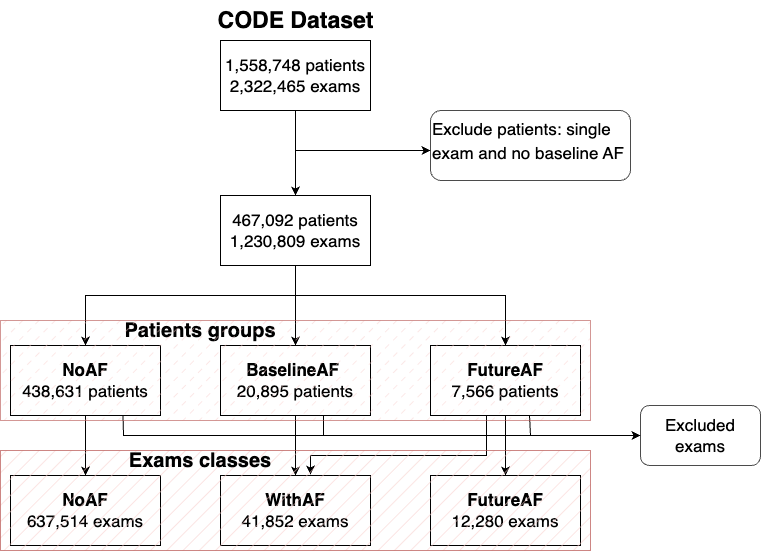Scripts and modules for training and testing deep neural networks for predicting the risk of atrial fibrilation. In addition, codes for developing survival models in order to make risk analysis are provided. The paper is available at the link.
Citation:
"End-to-end Risk Prediction of Atrial Fibrillation from the 12-Lead ECG by Deep Neural Networks."
Theogene Habineza, Antônio H. Ribeiro, Daniel Gedon, Joachim A. Behar, Antonio Luiz P. Ribeiro, Thomas B. Schön
Under review.
This project used one the CODE dataset for model development and testing. The CODE dataset consists of 2,322,465 12-lead ECG records from 1,558,748 different patients. The full CODE dataset is available upon request for research purposes: doi: 10.17044/scilifelab.15169716. A subset, the CODE-15% dataset, is openly available: doi: 10.5281/zenodo.4916206 .
The model uses as input the 12-lead ECG tracings and outputs the probability of one among three classes: (1) No AF and without risk, (2) AF condition, and (3) No AF but with impending risk. The figure bellow show how the patients and exams were divided into the three classes.
All the models developed during this study were implemented in Python. The codes in train.py and evaluate.py
were applied for training and evaluating the DNN model for the purpose of AF risk prediction. Both files use the
codes in resnet.py and dataloader.py modules.
The model developed in this project is a deep residual neural network. The neural network architecture implementation in pytorch is available in resnet.py. It follows closely this architecture, except that there is five residual blocks and a softmax at the last layer.
The model can be trained using the script train.py. Alternatively,
pre-trained weighs are available at doi.org/10.5281/zenodo.7038219 .
Using the command line, the weights can be downloaded using:
curl https://zenodo.org/record/7038219/files/af_pred_model.zip?download=1 --output model.zip
unzip model.zip
- model input:
shape = (N, 12, 4096). The input tensor should contain the 4096 points of the ECG tracings sampled at 400Hz (i.e., a signal of approximately 10 seconds). Both in the training and in the test set, when the signal was not long enough, we filled the signal with zeros, so 4096 points were attained. The last dimension of the tensor contains points of the 12 different leads. The leads are ordered in the following order: {DI, DII, DIII, AVR, AVL, AVF, V1, V2, V3, V4, V5, V6}. All signal are represented as 32 bits floating point numbers at the scale 1e-4V: so if the signal is in V it should be multiplied by 1000 before feeding it to the neural network model. - model output:
shape = (N, 3). The output corresponds to class probabilities for class 1 (No AF and without risk), class 2 (AF condition) and class 3 (No AF but with impending risk).
The following commands can be used to download the example dataset and the pre-trained model and evaluate the model on a example dataset.
# Download example dataset
curl https://zenodo.org/record/3765780/files/data.zip?download=1 --output data.zip
unzip data.zip
# Download model (if you have not done it already)
curl https://zenodo.org/record/7038219/files/af_pred_model.zip?download=1 --output model.zip
unzip model.zip # the folder containing the model will be named model_fdset_30Mar
# Evaluate the model
python evaluate.py model_fdset_30Mar data/ecg_tracings.hdf5 --traces_dset tracings --ids_dset "" --output predictions-codetest.csv
# As a sanity check compare the results with the provided predictions
# If correct you should get a message saying "Predicted probabilities are equal: True"
# otherwise, you will get "Predicted probabilities are equal: False"!!
python test/compare_results.py predictions-codetest.csv results/results-on-codetest.csv
Analogously, the file test/evaluate-code15pc.sh can be used to evaluate the model on
part of CODE-15% dataset and compare the file results/results-on-code.csv.
This code was tested on Python 3 with Pytorch 1.2. It uses numpy, pandas,
h5py for loading and processing the data and matplotlib and seaborn
for the plots. See requirements.txt to see a full list of requirements
and library versions.
For tensorflow users: If you are interested in a tensorflow implementation, take a look in the repository: https://github.com/antonior92/automatic-ecg-diagnosis. There we provide a tensorflow/keras implementation of the same resnet-based model. The problem there is the abnormality classification from the ECG, nonetheless simple modifications should suffice for dealing with age prediction
train.py: Script for training the neural network. To train the neural network run:
$ python train.py PATH_TO_HDF5 PATH_TO_CSVevaluate.py: Script for generating the neural network predictions on a given dataset.
$ python evaluate.py PATH_TO_MODEL PATH_TO_HDF5_ECG_TRACINGS --output PATH_TO_OUTPUT_FILE -
resnet.py: Auxiliary module that defines the architecture of the deep neural network. -
af_prediction_formulation.py: Script that separate patients into training, validation and test sets. CSV available upon request for research purposes at the doi10.17044/scilifelab.15169716.
$ python af_prediction_formulation.py PATH_TO_CSV -
notebooks/: Folder containing auxiliary notebooks for plotting and evaluating the model.-
notebooks/history_plot.ipynb: Auxiliary notebook for ploting the learning curve of the model. -
notebooks/af_performance.ipynb: Auxiliary notebook for evaluate the model performance. -
notebooks/survival_model.ipynb: Auxiliary notebook that contains codes for survival modelling.
-
-
result/: contain the results of the model evaluated on some dataset. -
archives/: contain intermediate files used along the model development.
OBS: Some scripts depend on the resnet.py and dataloader.py modules. So we recomend
the user to, either, run the scripts from within this folder or add it to your python path.
OBS2: The notebooks require some files that are not available in this repository! But we keep them here so one can look at the analysis and plots.
